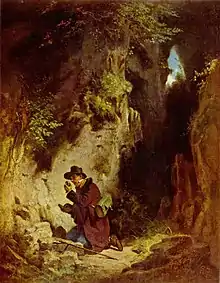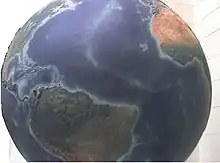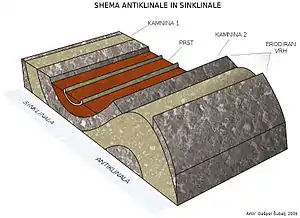Géologi
Citakan:WVS Géologi (tina basa Yunani γη- (ge-, "bumi") and λογος (logos, "kecap", "alesan")) nyaéta élmu jeung pangajaran ngeunaan bumi, kaasup kajadiannana, strukturna, sifat fisikna, sajarah, jeung prosés pembentukannana, mangrupa salah sahiji bagéan elmu bumi. Ahli geologi netepkeun umur bumi kira-kira 4.6 milyar (4.6x109) taun, sarta nangtukeun yén litosfer bumi, nu kaasup kerak, nyaéta bagéan tina tektonik lempeng nu pipindahan dina saluhureun rheic mantel bagian luhur (asthenosphere) ngaliwatan prosés nu nujul kana lempeng-lempeng tektonik. Ahli géologi mantuan néangan tur ngokolakeun sumber daya alam Bumi, saperti minyak bumi jeung batubara, ogé logam saperti beusi, tambaga, jeung uranium. ogé nu dipikaresep sacara ekonomi kaasup batu mulia tur mineral séjén saperti asbestos, perlite, mica, phosphates, zeolites, clay, pumice, quartz, sarta silica, ogé unsur séjén saperti sulfur, chlorine, jeung helium.

Kulit samudra ██ 0-20 Ma ██ 20-65 Ma ██ >65 Ma Propinsi géologis ██ Shield ██ Platform ██ Orogen ██ Basin ██ Large igneous province ██ Extended crust
Geologi luar angkasa (kadangkala disebut Astrogéology) nujul kana dipakéna prinsip géologi keur sistim surya mandala séjénna. Watesan husus saperti selenology (nalungtik moon), areology (keur Mars), jst., ilahar ogé dipaké. Dina basa sapopoe, geologi ogé ilahar dipaké dirangketkeun jeung kecap séjén keur ngajelaskeun hal salian ti bumi (upamana. "geologi planet Mars").
Kecap "geologi" mimiti dipaké ku Jean-André Deluc dina taun 1778 sarta diwanohkeun tur maké watesan nu tetep ku Horace-Bénédict de Saussure dina taun 1779. Elmu ieu teu kaasup dina Encyclopedia Britannica edisi katilu nu lengkep dina 1797, tapi mimiti asup sacara jéntré dina edisi kaopat nu lengkep dina 1809.[1] Harti nu leuwih ti heula mimiti dipaké ku Richard de Bury keur ngabédakeun antara ka-bumi-an jeung yurisprudensi theologi.
|
|
Artikel ieu keur dikeureuyeuh, ditarjamahkeun tina basa Inggris. Bantuanna didagoan pikeun narjamahkeun. |
Sajarah
Karya Peri Lithon (Dina Batu, Ing: On Stones) ku Theophrastus (372-287 BC), salah saurang murid Aristoteles, bukti nyata keur abad kiwari. Interpréatsi fossils ieu teu pernah dibuka nepi anggeusna Revolusi Elmu tur ditarjamahkeun kana Basa Latin sarta sababaraha basa asing séjénna.
Sababaraha ahli kiwari, saperti Fielding H. Garrison, boga nyebutkeun yén elmu géologi modérn dimimitian dina zaman Muslim.[2] Abu al-Rayhan al-Biruni (973-1048 AD) dianggap salaku ahli géologi Muslim modérn, karya munggaranna nyaéta geologi India.[3] Ibnu Sina (Avicenna, 981 - 1037 C.E.), dina hal husus, méré kontribusi nyata kana elmu alam (nu disebut Attabieyat) bareng jeung filsuf séjénna saperti Ikhwan AI-Safa jeung nu séjénna. Enslikopedi karya anjeunna nyaéta “Kitab AI-Shifa” (the Book of Cure, Héaling or Remedy from ignorance), dina bagéan 2, seksi 5, nulis ngeunaan Mineral jeung Metéorologi, dina bab genep: Formasi gunung-gunung, The advantages of mountains in the formation of clouds; Sources of water; Origin of éarthquakes; Formation of minerals; The diversity of éarth’s terrain. These principles were later known in the Renaissance of Europe as the law of superposition of strata, the concept of catastrophisim, and the doctrine of uniformitarianism. These concepts were also embodied in the Théory of the éarth by James Hutton in the Eighteenth century C.E. Academics such as Toulumin and Goodfield (1965), commented on Avicenna's contribution: "Around A.D. 1000, Avicenna was already suggesting a hypothesis about the origin of mountain ranges, which in the Christian world, would still have been considered quite radical eight hundred years later".[4]
In China, the polymath Shen Kua (1031-1095) formulated a hypothesis for the process of land formation: based on his observation of fossil shells in a géological stratum in a mountain hundreds of miles from the océan, he inferred that the land was formed by erosion of the mountains and by deposition of silt.
Georg Agricola (1494-1555), a physician, wrote the first systematic tréatise about mining and smelting works, De re metallica libri XII, with an appendix Buch von den Lebewesen unter Tage (Book of the Créatures Benéath the éarth). He covered subjects like wind energy, hydrodynamic power, melting cookers, transport of ores, extraction of soda, sulfur and alum, and administrative issues. The book was published in 1556. Nicolas Steno (1638-1686) is credited with the law of superposition, the principle of original horizontality, and the principle of lateral continuity: three defining principles of stratigraphy. Previous attempts at such statements meet accusations of heresy from the Church.[rujukan?]
By the 1700s Jean-Étienne Guettard and Nicolas Desmarest hiked central France and recorded their observations on geological maps; Guettard recorded the first observation of the volcanic origins of this part of France.
William Smith (1769-1839) drew some of the first géological maps and began the process of ordering rock strata (layers) by examining the fossils contained in them.
James Hutton is often viewed as the first modérn géologist. In 1785 he presented a paper entitled Theory of the Earth to the Royal Society of Edinburgh. In his paper, he explained his théory that the éarth must be much older than had previously been supposed in order to allow enough time for mountains to be eroded and for sediments to form new rocks at the bottom of the séa, which in turn were raised up to become dry land. Hutton published a two-volume version of his idéas in 1795 (Vol. 1, Vol. 2).

Followers of Hutton were known as Plutonists because they believed that some rocks were formed by vulcanism which is the deposition of lava from volcanoes, as opposed to the Neptunists, who believed that all rocks had settled out of a large océan whose level gradually dropped over time.
In 1811 Georges Cuvier and Alexandre Brongniart published their explanation of the antiquity of the éarth, inspired by Cuvier's discovery of fossil elephant bones in Paris. To prove this, they formulated the principle of stratigraphic succession of the layers of the éarth. They were independently anticipated by William Smith's stratigraphic studies on England and Scotland.
By 1827 Charles Lyell's Principles of Geology reiterated Hutton's uniformitarianism, which influenced the thought of Charles Darwin.
Sir Charles Lyell first published his famous book, Principles of Geology, in 1830 and continued to publish new revisions until he died in 1875. He successfully promoted the doctrine of uniformitarianism. This théory states that slow géological processes have occurred throughout the Earth's history and are still occurring today. In contrast, catastrophism is the théory that éarth's féatures formed in single, catastrophic events and remained unchanged theréafter. Though Hutton believed in uniformitarianism, the idéa was not widely accepted at the time.

19th century géology revolved around the question of the Earth's exact age. Estimates varied from a few 100,000 to billions of yéars. The most significant advance in 20th century géology has been the development of the théory of plate tectonics in the 1960s. Plate tectonic théory arose out of two separate géological observations: seafloor spreading and continental drift. The théory revolutionized the Earth sciences.
The théory of continental drift was proposed by Frank Bursley Taylor in 1908, expanded by Alfred Wegener in 1912 and by Arthur Holmes, but wasn't broadly accepted until the late 1960s when the théory of plate tectonics was developed.
Prinsip-prinsip penting dina géologi
There are a number of important principles in géology. Many of these involve the ability to provide the relative ages of strata or the manner in which they were formed.
The principle of intrusive relationships concerns crosscutting intrusions. In géology, when an igneous intrusion cuts across a formation of sedimentary rock, it can be determined that the ignéous intrusion is younger than the sedimentary rock. There are a number of different types of intrusions, including stocks, laccoliths, batholiths, sills and dikes.
The principle of cross-cutting relationships pertains to the formation of faults and the age of the sequences through which they cut. Faults are younger than the rocks they cut; accordingly, if a fault is found that penetrates some formations but not those on top of it, then the formations that were cut are older than the fault, and the ones that are not cut must be younger than the fault. Finding the key bed in these situations may help determine whether the fault is a normal fault or a thrust fault.
The principle of inclusions and components states that, with sedimentary rocks, if inclusions (or clasts) are found in a formation, then the inclusions must be older than the formation that contains them. For example, in sedimentary rocks, it is common for gravel from an older formation to be ripped up and included in a newer layer. A similar situation with ignéous rocks occurs when xenoliths are found. These foreign bodies are picked up as magma or lava flows, and are incorporated, later to cool in the matrix. As a result, xenoliths are older than the rock which contains them.
The principle of uniformitarianism states that the géologic processes observed in operation that modify the éarth's crust at present have worked in much the same way over géologic time. A fundamental principle of géology advanced by the 18th century Scottish physician and géologist James Hutton, is that "the present is the key to the past." In Hutton's words: "the past history of our globe must be explained by what can be seen to be happening now."
The principle of original horizontality states that the deposition of sediments occurs as essentially horizontal beds. Observation of modérn marine and non-marine sediments in a wide variety of environments supports this generalization (although cross-bedding is inclined, the overall orientation of cross-bedded units is horizontal).
The principle of superposition states that a sedimentary rock layer in a tectonically undisturbed sequence is younger than the one benéath it and older than the one above it. Logically a younger layer cannot slip benéath a layer previously deposited. This principle allows sedimentary layers to be viewed as a form of vertical time line, a partial or complete record of the time elapsed from deposition of the lowest layer to deposition of the highest bed.
The principle of faunal succession is based on the appéarance of fossils in sedimentary rocks. As organisms exist at the same time period throughout the world, their presence or (sometimes) absence may be used to provide a relative age of the formations in which they are found. Based on principles laid out by William Smith almost a hundred yéars before the publication of Charles Darwin's theory of evolution, the principles of succession were developed independently of evolutionary thought. The principle becomes quite complex, however, given the uncertainties of fossilization, the localization of fossil types due to lateral changes in habitat (facies change in sedimentary strata), and that not all fossils may be found globally at the same time.

Géologi regional
- Géologi Alpén
- Géologi Appalachia
- Géologi Himalaya
Dumasar nagara
- Géologi Australia
- Géologi Daerah Ibukota Australia
- Géologi Victoria
- Géologi Kraton Yilgarn
- Géologi Tiongkok
- Géologi Taiwan
- Géologi Éropa
- Géologi Belanda
- Géologi Britania Raya
- Géologi Inggris
- Geology of Dorset
- Geology of Hampshire
- Geology of Hertfordshire
- Geology of Shropshire
- Geology of Lizard, Cornwall
- Géologi Skotlandia
- Géologi Wales
- Géologi Inggris
- Geology of the Falkland Islands
- Géologi India
- Géologi Sikkim
- Géologi Jepang
- Géologi Nigéria
- Géologi Amérika Sarékat
- Géologi nagara bagéan AS:
- Geology of California
- Geology of Connecticut
- Geology of Georgia
- Geology of Idaho
- Geology of Illinois
- Geology of Minnesota
- Geology of Pennsylvania
- Geology of Tennessee
- Geology of Texas
- US Geology by region or feature:
- Geology of the Appalachians
- Geology of the Pacific Northwest
- Geology of the Bryce Canyon area(Utah)
- Geology of the Canyonlands area (Utah)
- Geology of the Capitol Reef area (Utah)
- Geology of the Death Valley area (California)
- Geology of the Grand Canyon area (Arizona)
- Geology of the Grand Teton area (Wyoming)
- Geology of the Lassen area (California)
- Geology of Mount Adams (Washington)
- Geology of Mount Shasta (California)
- Geology of the Yosemite area (California)
- Geology of the Zion and Kolob canyons area (Utah)
- Glacial geology of the Genesee River (New York, Pennsylvania)
- Géologi nagara bagéan AS:
Geologi luar angkas

- Géologi Mérkurius
- Géologi Vénus
- Géologi Bulan
- Géologi Mars
- Géologi Jupiter
- Géologi Saturnus
- Géologi Uranus
- Géologi Néptunus
Rujukan
- Winchester, Simon (2001). The Map that Changed the World. HarperCollins Publishers. p. 25. ISBN 0-06-093180-9
- Fielding H. Garrison wrote in the History of Medicine:
"The Saracens themselves were the originators not only of algebra, chemistry, and geology, but of many of the so-called improvements or refinements of civilization, such as street lamps, window-panes, firework, stringed instruments, cultivated fruits, perfumes, spices, etc."
- Abdus Salam (1984), "Islam and Science". In C. H. Lai (1987), Ideals and Realities: Selected Essays of Abdus Salam, 2nd ed., World Scientific, Singapore, p. 179-213.
- Toulumin, S. and Goodfield, J. (1965), ’The Ancestry of science: The Discovery of Time’, Hutchinson & Co., London, p.64. Also see http://muslimheritage.com/topics/default.cfm?ArticleID=319 Archived 2010-03-14 di Wayback Machine
Tempo ogé
- Agrogeology
- Geochemistry
- Geologist
- Geologic modeling
- Geologic time scale
- International Union of Geological Sciences (IUGS)
- List of geology topics
- List of fossil sites (with link directory)
- List of minerals
- List of rock types
- Important publications in geology
- List of rock textures
- Mineral
- Timeline of geology
- Paleorrota
Tumbu luar
- James Hutton's Theory of the Earth
- James Hutton's Theory of the Earth & Abstract of the Theory of the Earth
Citakan:Nature nav